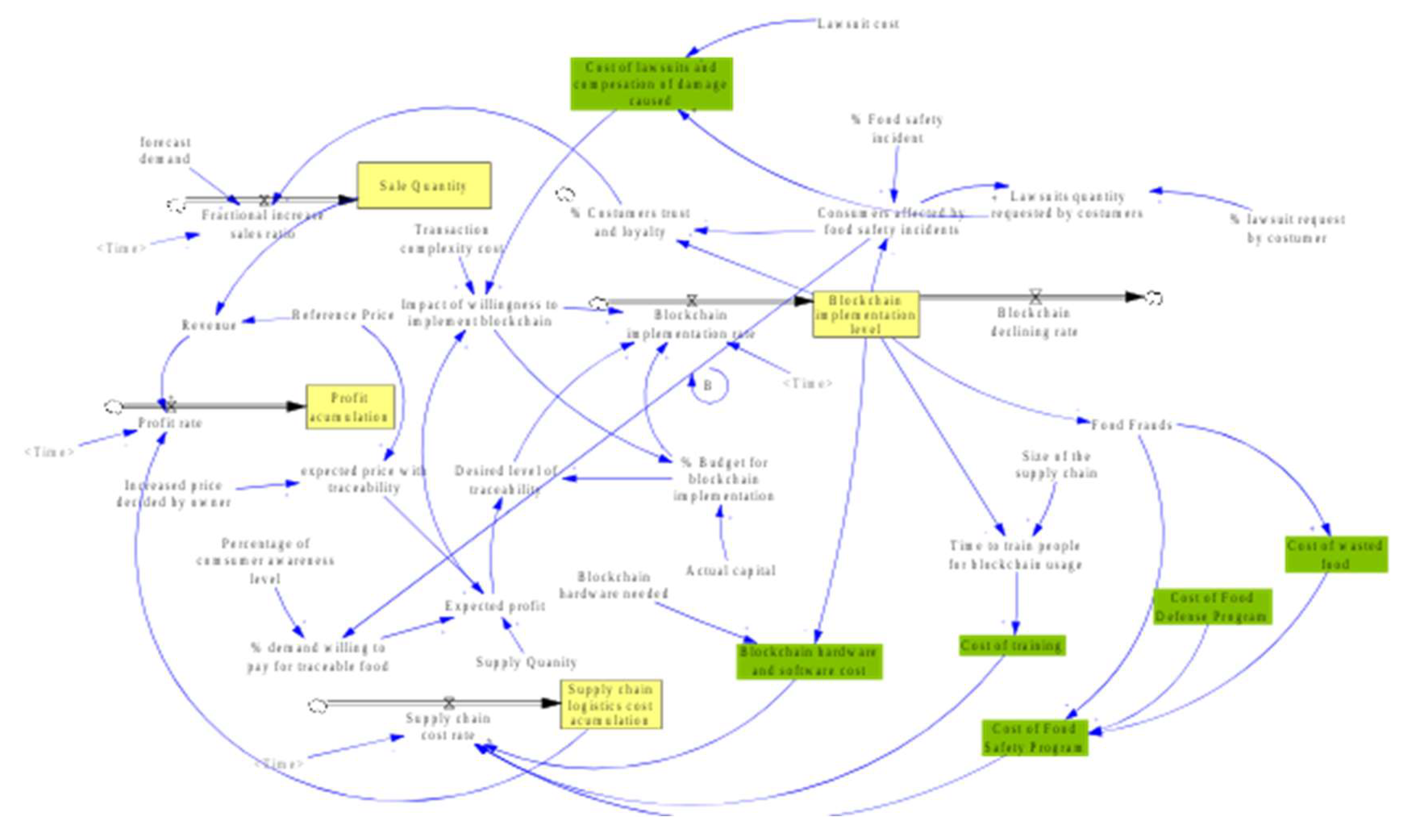Impact of Blockchain Adoption for Safe Food Supply Chain Management through System Dynamics Approach from Management Perspectives in Thailand †
Abstract
:1. Introduction
2. Literature Review
3. Methodology
4. Result and Discussion
5. Conclusions
Acknowledgments
References
- Walker, M.A. Survey of Food Consumption in Thailand; Centre for Asia-Pacific Initiatives: Oak Bay, BC, Canada, 1996. [Google Scholar]
- Helo, P.; Hao, Y. Blockchains in operations and supply chains: A model and reference implementation. Comput. Ind. Eng. 2019, 136, 242–251. [Google Scholar] [CrossRef]
- Zhao, G.; Liu, S.; Lopez, C.; Lu, H.; Elgueta, S.; Chen, H.; Boshkoska, B.M. Blockchain technology in agri-food value chain management: A synthesis of applications, challenges and future research directions. Comput. Ind. 2019, 109, 83–99. [Google Scholar] [CrossRef]
- Francisco, K.; Swanson, D. The supply chain has no clothes: Technology adoption of blockchain for supply chain transparency. Logistics 2018, 2, 2. [Google Scholar] [CrossRef]
- Hackius, N.; Petersen, M. Blockchain in logistics and supply chain: Trick or treat? In Proceedings of the Hamburg International Conference of Logistics (HICL), Hamburg, Germany, 17 October 2017; pp. 3–18. [Google Scholar]
- Bruce, J.D. Purely P2P Crypto-Currency with Finite Mini-Blockchain. 2013. Available online: http://www.bitfreak.info/files/pp2p-ccmbc-rev1.pdf/ (accessed on 29 November 2019).
- Alfred Taudes, U.-P.; Tian, F. An Information System for Food Safety Monitoring in Supply Chains Based on HACCP, Blockchain and Internet of Things. Ph.D. Thesis, WU Vienna University of Economics and Business, Vienna, Austria, 2018; pp. 63–102. [Google Scholar] [CrossRef]
- Peterson, M.R.; Young, R.R.; Gordon, G.A. The application of supply chain management principles to emergency management logistics: An empirical study. J. Emerg. Manag. 2016, 14, 245–258. [Google Scholar] [CrossRef] [PubMed]
- Bosona, T.; Gebresenbet, G. Food traceability as an integral part of logistics management in food and agricultural supply chain. Food Control 2013, 33, 32–48. [Google Scholar] [CrossRef]
- Noomhorm, A.; Ahmad, I. Food Supply Chain Management and Food Safety: South & East-Asia Scenario, Agricultural Information Research. 2008. Available online: www.jstage.jst.go.jp/ (accessed on 29 November 2019).
- Caro, M.P.; Ali, M.S.; Vecchio, M.; Giaffreda, R. Blockchain-based traceability in Agri-Food supply chain management: A practical implementation. In Proceedings of the 2018 IoT Vertical and Topical Summit on Agriculture—Tuscany (IOT Tuscany), Tuscany, Italy, 8–9 May 2018; pp. 1–4. [Google Scholar] [CrossRef]
- Forrester, J.W. Industrial Dynamics; MIT Press: Cambridge, MA, USA, 1961. [Google Scholar]
- Sterman, J.D. Modelling managerial behaviour: Misperceptions of feedback in a dynamic decision-making experiment. Manag. Sci. 1989, 35, 321–339. [Google Scholar] [CrossRef]
- Minegishi, S.; Thiel, D. System dynamics modeling and simulation of a particular food supply chain. Simul. Pract. Theory 2000, 8, 321–339. [Google Scholar] [CrossRef]
- Georgiadis, P.; Vlachos, D.; Iakovou, E. A system dynamics modeling framework for the strategic supply chain management of food chains. J. Food Eng. 2005, 70, 351–364. [Google Scholar] [CrossRef]

© 2020 by the authors. Licensee MDPI, Basel, Switzerland. This article is an open access article distributed under the terms and conditions of the Creative Commons Attribution (CC BY) license (http://creativecommons.org/licenses/by/4.0/).
Share and Cite
Tipmontian, J.; Alcover, J.C.; Rajmohan, M. Impact of Blockchain Adoption for Safe Food Supply Chain Management through System Dynamics Approach from Management Perspectives in Thailand. Proceedings 2019, 39, 14. https://doi.org/10.3390/proceedings2019039014
Tipmontian J, Alcover JC, Rajmohan M. Impact of Blockchain Adoption for Safe Food Supply Chain Management through System Dynamics Approach from Management Perspectives in Thailand. Proceedings. 2019; 39(1):14. https://doi.org/10.3390/proceedings2019039014
Chicago/Turabian StyleTipmontian, Jedsada, Jaime Castellanos Alcover, and M. Rajmohan. 2019. "Impact of Blockchain Adoption for Safe Food Supply Chain Management through System Dynamics Approach from Management Perspectives in Thailand" Proceedings 39, no. 1: 14. https://doi.org/10.3390/proceedings2019039014
APA StyleTipmontian, J., Alcover, J. C., & Rajmohan, M. (2019). Impact of Blockchain Adoption for Safe Food Supply Chain Management through System Dynamics Approach from Management Perspectives in Thailand. Proceedings, 39(1), 14. https://doi.org/10.3390/proceedings2019039014



